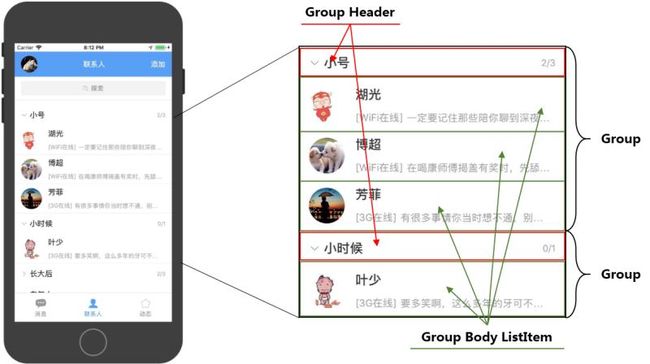前言
今天想跟大家分享一个用RN实现的组件 - ExpandableList。恩,没什么特殊的原因,只是因为最近有一个需求要用到这东西,而且RN没有提供现成的组件,所以做了一个。下面两张图是用这个组件实现的两个demo,github地址在这儿,有兴趣的可以戳https://github.com/SmallStoneSK/react-native-expandable-list瞅一眼,喜欢的还可以star一个~
如果有哪说的不对的,欢迎指出哦~
讨论与分析
好了,废话不多说,直接进入正题。首先,我们先确定下要解决的问题:
- 组件结构怎么表示?
- 展开/收起动画怎么过渡?
- API设计成怎样让组件的实用性更强?
1. 第一个问题
我们先将ExpandableList这个组件拆解一下,看看都有哪些部分。看下面的这张图,我们可以把一个ExpandableList看成是由一个个Group组成的,而每个Group又了包含GroupHeader和GroupBody,而其实GroupBody本身又是一个List。
分析完结构之后,思路瞬间就有了,这个结构用两个循环就可以表示出来了,就像下面这样:
{data.map((groupItem, groupIndex) => {
return (
{renderGroupHeader.bind(this, groupItem. groupHeaderData, groupIndex)}
{groupItem.groupListData.map((listItemData, listItemIndex) => {
return (
{renderListItem.bind(this, listItemData, groupIndex, listItemIndex)}
);
})}
);
})}
2. 第二个问题
没错,结构是很轻易地表示出来了。但是问题来了,展开收起的这个动画过程应该怎么现实呢?我们都知道在RN中如果要实现动画,那Animated绝对是把好手。借助Animated,我们可以很精准地控制动画的实现,当然也包括这里的展开/收起动画。但是在这里,就不劳烦这尊大佛啦~因为借助LayoutAnimation,我们可以实现地更优雅(其实就是偷懒)。
在讲LayoutAnimation之前,不妨先回顾下web中的transition。为啥捏?因为个人觉得这两者就是很像,只要给定了初始状态和终止状态,那这中间的动画切换过程就不需要我们关心了。再来看这个展开/收起的动画,是不是很符合这个条件。每个group都有两种状态,即open和closed。因此,当closed时,我们设置groupBody的height为0就可以了。
3. 第三个问题
为什么要考虑API的设计呢?因为这个组件实在太简单,感觉都编不下去了,不找个主题怎么凑字数。。。当然,这是玩笑话。实际上,在封装这个组件的时候,还是遇到了一些调用上的问题,就比如:
- 如何关联起TouchableXXX和展开/收起动画: 毫无疑问,展开/收起动画是这个组件本身就应该包掉的逻辑。但是,不同需求的groupHeader样式都是各式各样的,就比如最一开始的两个demo图。很明显,两个点击区域都不同,但是点击之后都要有展开/收起的功能,动画的同时还有不同的点击功能。或许你会想到传一个回调函数给ExpandableList,在点击GroupHeader的时候调用这个回调就好了。But,再仔细想想,别忘了TouchableXXX这一部分可是在自定义样式中的,所以ExpandableList组件中是不会包掉touch操作的,那传进来的回调到哪里去调用。。。
- 如何提高组件的性能: 上面虽然用了一个很粗浅的方法大概模拟了下组件的组成,但是很明显,用到的全是View。而既然是ExpandableList,怎么也得对得起List这个词吧。。。这可是个列表,要是数据多了,渲染性能肯定不好。因此,我们或许可以用ListView甚至FlatList来实现。不过也别忘了低版本的RN还不支持FlatList,所以需要做一个降级处理。既然这里有那么多种实现方式,那为何不暴露一个选项让用户选择ExpandableList组件到底是用哪种模式来构成。
- 展开/关闭的状态维持: 因为ExpandableList组件包掉了展开/收起动画这些操作,那组件内部势必要保存所有group的展开/收起状态。而调用ExpandableList的组件应不应该也保存一份这些展开/收起状态呢?就拿上面的仿QQ的那个demo为例,注意每个分组在展开和收起的时候,最前面的箭头样式是不一样的。所以问题就来了,groupStatus是存储在组件内部的数据,而在renderGroupHeader的时候,FriendList难道也要存储一份所有group的展开/收起状态?很显然,这种信息都是冗余的。而且一旦有两份数据,如何确保和组件内部的状态数组保持同步。这些工作无疑都不应该成为使用者的负担。
- 数据传递 这个比较简单一点,就是用户怎么知道自己点击的是第几个group,以及是当前group中的第几个listItem。
这些问题在接下来的代码中都会有答案,所以请继续往下看吧。
实现
1. 先定暴露给调用方的API
我们可以先敲定一下基础的暴露出来的接口方法:
| 属性 | 值类型 | 解释 |
|---|---|---|
| data | Array | ExpandableList的中的数据,数组中每个对象由groupHeaderData和groupListData构成 |
| style | object | 作用在ExpandableList上的样式 |
| groupStyle | object | 作用在每个group上的样式 |
| groupSpacing | number | group之间的间隙 |
| implementedBy | string | 组件实现方式,一共有'View', 'ListView', 'FlatList'三种方式可选,默认值'FlatList' |
| renderGroupHeader | function | 渲染GroupHeader的方法 |
| renderGroupListItem | function | 渲染GroupListItem的方法 |
所以,我们可以这么调用
2. 搭骨架
import React, {Component} from 'react';
import {
View,
ListView,
ScrollView,
FlatList,
LayoutAnimation
} from 'react-native';
export class ExpandableList extends Component {
constructor(props) {
super(props);
this._supportFlatList = this. _supportFlatList.bind(this);
this._renderUsingView = this._renderUsingView.bind(this);
this._renderUsingFlatList = this._renderUsingFlatList.bind(this);
this._renderUsingListView = this._renderUsingListView.bind(this);
}
_supportFlatList() {
return !!FlatList;
}
_renderUsingFlatList() {
// ...
}
_renderUsingView() {
// ...
}
_renderUsingListView() {
// ...
}
render() {
const strategy = {
'View': this._renderUsingView,
'ListView': this._renderUsingListView,
'FlatList': this._supportFlatList() ? this._renderUsingFlatList : this._renderUsingListView
};
let {implementedBy} = this.props;
if(!strategy[implementedBy]) {
implementedBy = 'FlatList';
}
return strategy[implementedBy]();
}
}
根据上面代码中的render方法可以看到,最终使用哪种方式渲染我们的ExpandableList,完全取决于implementedBy是什么,也就是把这个决定权交给调用的人。当implementedBy的值没有设置,或者是一个不合法的值的时候,我们默认就使用FlatList来实现。而且,还对FlatList进行了降级处理,如果不支持FlatList的话,就用ListView代替实现。
3. 填坑
坑一:维护所有group的open/closed状态
因为每一个group都有自身的open/closed状态,所以倒不如在state中维护一个状态数组。而且啊,考虑到假如有这么一个场景:列表在刚渲染出来的时候,有几个group是open的,有几个group是closed的。所以,我们可以这么设计:
export class ExpandableList extends Component {
constructor(props) {
super(props);
this.state = {
groupStatus: this._getInitialGroupStatus()
};
}
_getInitialGroupStatus() {
const {initialOpenGroups = [], data = []} = this.props;
// true代表open, false代表closed
return new Array(data.length)
.fill(false)
.map((item, index) => {
return initialOpenGroups.indexOf(index) !== -1;
});
}
}
坑二:3种不同的render实现
因为不管用哪种方式去渲染,每个group的结构是相同的,所以倒不如封装一个_renderGroupItem方法,让这3种不同的render方法调用。也就是这样:
export class ExpandableList extends Component {
toggleOpenStatus(index, closeOthers) {
// 支持在切换自身状态的时候,同时把其他的group都关闭
const newGroupStatus = this.state.groupStatus.map((status, idx) => {
return idx !== index ? (closeOthers ? false : status) : !status;
});
this.setState({
groupStatus: newGroupStatus
});
}
_renderGroupItem(groupItem, groupId) {
const status = this.state.groupStatus[groupId];
const {groupHeaderData = [], groupListData = []} = groupItem;
const {renderGroupHeader, renderGroupListItem, groupStyle, groupSpacing} = this.props;
const groupHeader = renderGroupHeader && renderGroupHeader({
status,
groupId,
item: groupHeaderData,
toggleStatus: this.toggleGroupStatus.bind(this, groupId)}
);
const groupBody = groupListData.length > 0 && (
{groupListData.map((listItem, index) => (
{renderGroupListItem && renderGroupListItem({
item: listItem,
rowId: index,
groupId
})}
))}
);
return (
{groupHeader}
{groupBody}
);
}
_renderFlatListItem({item, index}) {
return this._renderGroupItem(item, index);
}
_renderListViewItem(rowData, groupId, rowId) {
return this._renderGroupItem(rowData, parseInt(rowId));
}
_renderUsingFlatList() {
const {data=[], style} = this.props;
return (
index}
renderItem={this._renderFlatListItem}
/>
);
}
_renderUsingView() {
const {data = [], style} = this.props;
return (
{data.map((item, groupId) => {
return this._renderGroupItem(item, groupId);
})}
);
}
_renderUsingListView() {
const {data = [], style} = this.props;
return (
r1 !== r2
}).cloneWithRows(data)}
/>
);
}
}
稍微分析下上面的代码:
_renderUsingView, _renderUsingListView, _renderUsingFlatList三个函数分别代表三种不同的实现方式,但是最终都调用到了_renderGroupItem。
-
_renderGroupItem分两个部分渲染:header和body。但是需要注意的是,在执行renderGroupHeader方法的时候,注意其中的参数。还记得文章一开始讨论的几个问题吗?status, groupId, item, toggleStatus这四个参数就能解决之前的疑惑了。
- status:当前group的展开/收起状态。通过它,我们在实现自定义GroupHeader的时候就可以知道目前的状态是什么了,从而控制不同状态下的样式展示。
- groupId:当前的group索引。
- item:当前的groupHeaderData。
- toggleStatus:这是一个方法,调用它可以控制当前group的展开/收起状态。之前讨论过touchableXXX的问题,最终可以通过它来折中实现。即调用方在使用ExpandableList组件的时候,不是要传一个renderGroupHeader属性吗,在用户实现自定义的renderGroupHeader的时候,我们把toggleStatus方法作为回调传回给renderGroupHeader。这样一来,作为组件内部就不需要关心调用方的touchableXXX是怎么样的,反正我已经把这个开关的权限交给你,你想怎么调用就怎么调用。
小扩展:对于toggleOpenStatus,我们还加了一个closeOthers的可选项。支持用户在展开某一个group的同时关闭其他的group,具体实现看代码就好了,非常简单。
坑三:动画实现
前面就提到过,用LayoutAnimation来实现我们的动画将非常简单。由于在之前的代码中,我们已经通过status来控制整个groupBody的height,所以我们只要这样就可以:
export class ExpandableList extends Component {
componentWillUpdate() {
LayoutAnimation.easeInEaseOut(); // 也可以用LayoutAnimation.spring()
}
}
是的,就只需要这一行代码,列表在展开/收起的时候就不会干巴巴的了。LayoutAnimation会自动计算height,并提供一个流畅的动画。
写在最后
说实话,其实代码很简单,只是用现成的组件进行一个封装,但是要把方方面面的东西都考虑全了,还真是不容易。所以上面的代码肯定还有可以优化的地方,以及扩展更多的功能。
最后还是照惯例再贴个github的地址吧:https://github.com/SmallStoneSK/react-native-expandable-list


